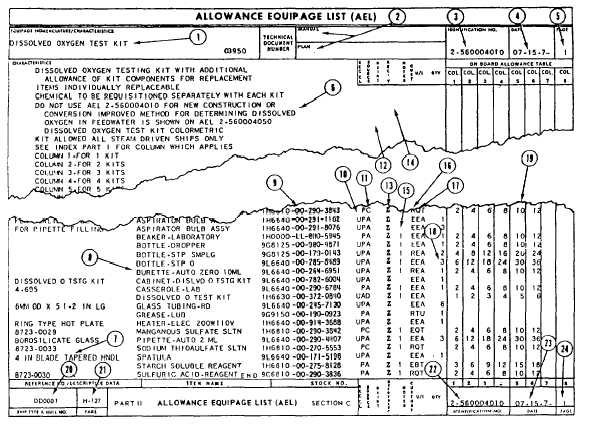2. The APL provides technical information for the
person maintaining a piece of equipment and tells the
supply officer what repair parts are necessary in the
storeroom to support it, and the AEL tells the
commanding officer, supply officer, and other heads of
departments what equipage and supplies are required to
operate the ship.
Equipage is defined as durable items that are not
consumed in use and that are essential to the ship’s
mission. Some examples are typewriters, portable
power tools (electric drills and pneumatic hammers, life
preservers, special clothing, and test sets).
AELs may be used to tailor an equipage allowance
to fit the needs of a specific ship, and the commanding
officer is responsible for carrying the full allowance on
board. The consumable supplies listed on the AELs are
not mandatory allowances, but they help the supply
officer and using department decide what to order.
Figure 5-5 shows a typical AEL, and the following list
explains the data blocks and columns.
1. Equipage nomenclature/characteristics: Name
of equipage or the mechanical/electrical system.
2.
3.
4,
5.
Manual/Plan: The predominate technical
manual and/or plan number. Items 6 and 7 may
show additional numbers.
Identification number: the number assigned to
identify a specific AEL. The first digit followed
by a (-) identifies the activity responsible for
preparation and maintenance of the AEL, and
the general significance of the equipage.
0–Ordinance material
1–Space/systems-related material
2–Miscellaneous material
3–Automotive, construction, and material
handling equipment
4–Flag allowance material
5–Special project office material
6–Special propulsion plant
7–Portable electronic material
Date: COSAL publication date.
Page: Consecutive numbering of all pages
required to desccribc a system and covered by
Figure 5-5.-Example of an AEL.
5-11


